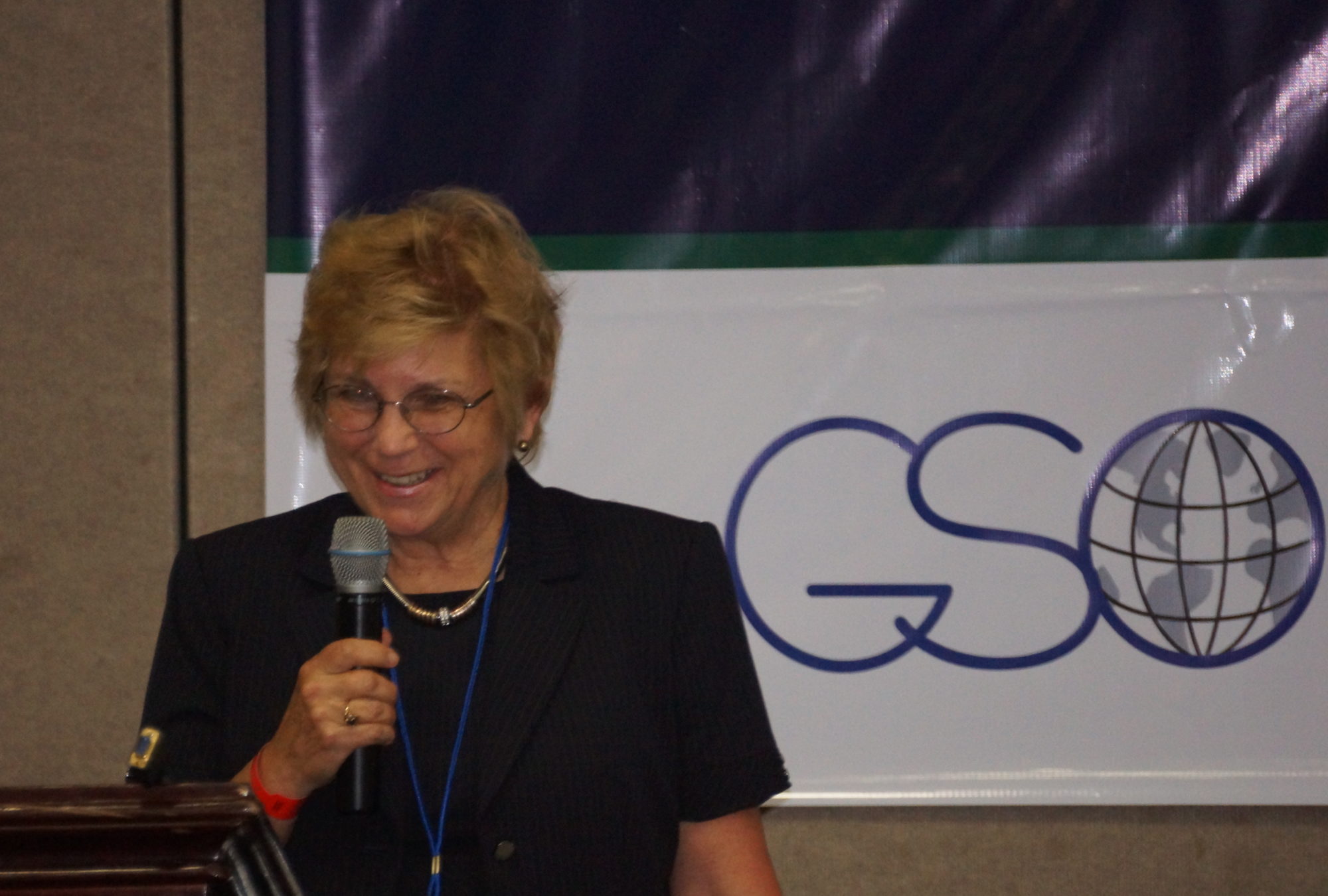International Women’s Day is celebrated each year on 8 March. This year’s theme was chosen to be “Balance for Better”. As a feminist who has supported gender equality in various settings throughout my career, I have found it a useful segue into semi-retirement life to investigate how my local community chooses to celebrate this day. Last year, I was drawn to the artistic rendering of the day in the nearby village of Peymeinade, where I was deeply moved by the impressive exhibit of the paintings of three generations of women artists whose portraits captured the personalities of a representative sampling of women pioneers in history. (See my report of this event here, and a translation into French by the lead artist, Leila Zarif, here.)
This year, I was intrigued by a rather different event hosted by the Soroptimist Club of the Pays de Grasse on “Les Femmes en parfumérie”. How timely that this colloquium would tackle the challenges and opportunities for women in the perfume industry – just when the Pays de Grasse has been blessed by the UNESCO designation of its unique heritage for perfume. As reported in my commentary about the role of past and future in the work of UNESCO (available here), this designation was only recently approved in November 2018 under the UNESCO convention for protecting intangible heritages around the world.
For this particular designation, UNESCO has recognized the traditional expertise, from cultivation of plants with special fragrances to the extraction of their “essences” to their transformation into perfumes, which serve as the rationale for Grasse to call itself the “perfume capital of the world”. Given the historic dominance of men in the perfume industry (hard to believe but true), the colloquium was a serendipitous choice by the Soroptimists to connect the theme of International Women’s Day to the local setting.
The colloquium reportedly took two years for the Soroptimist Club of the Pays de Grasse to organize. It was indeed a major project, featuring a full day of presentations in the form of individual speakers and panels on the history of women’s involvement in the perfume industry and challenges facing women in the production, extraction and composition of perfumes, and on the future prospects for women in the industry, specifically in the context of the future of the perfume industry in Grasse. The Pays de Grasse club, in should be noted, is part of a global network (Soroptimist International) of professional women in over 3000 clubs in 123 countries to collaborate on promoting opportunities for women and girls in education, health, leadership, autonomy and freedom from sexual harassment and violence. It is much like a parallel network known today as Graduate Women International (formerly known as the International Federation of University Women), in which I was personally active as their representative at the annual conferences of the International Labour Organization.
The event itself had a full-day agenda plus an artist who did on-the-spot graphics summarizing the main points of each session. It was especially useful to consult the graphics as a means of verifying the messages emanating from the rapid French of the speakers for someone whose claim to bilingualism between English and French is a bit ambitious!
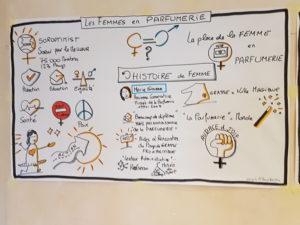
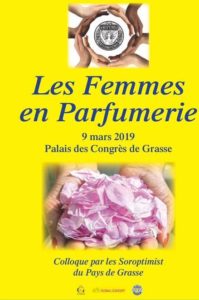
The Historical Overview of Women in Perfumery
Historically, it seems, there were a few women who were visible in the perfume world. Two were featured in the historical overview for their roles in developing specific perfumes, while others were directly associated with the perfume industry in Grasse (although mostly as spouses of the main figures, it seems). More interesting from a historical perspective were the presentations from two women who had managed to make successful careers as “perfumers” in the latter part of the twentieth century and were still active in their respective businesses.
Three observations about the past have some bearing on the future. First, success seems to have been predicated upon a family connection with the business to start with. The success stories did seem to highlight the somewhat accidental falling into the business because it was where the family was already well ensconced. Although this may not be as significant today as it was back in the 1970s or 1980s or even the 1990s, it does seem that there is a strong bias to “inherited” knowledge and familiarity with who does what that is still ingrained in the industry.
Second, there were certain educational paths that played a key role – and probably still do. One is a knowledge of chemistry and an interest in applying this knowledge in a laboratory setting. Pharmacies are also an experiential avenue, it seems, especially in the French context where pharmacies are also an important channel for cosmetics. Thus, an interest in cosmetics seems to open up the links to fragrances as a part of the cosmetics world. Similarly, there was an example of a child growing up with a special interest in the smells of flowers that led her applying her love of flowers to working on capturing fragrances more generally.
Third, it seems that success came for women who operated independently in the field, rather than working for a large enterprise in the industry. This requires resources from some source to start with, of course, but the point seems to be that independence is especially significant for whomever might be involved in the actual composition of fragrances into perfumes. This seems to be where women have been able to circumvent that male dominance in the industry otherwise. Thus, the individual “signature” of perfumes was highlighted as a key to doing well in the industry.
This definitely is what is linked, then, to the matter of what the “nose” is all about. That is to say, that long apprenticeship that is required for a “nose” is now more than ever associated with the ability of a “nose” to concoct a distinct olfactory creation. And that also suggests that the opportunities are there for women to operate independently as perfumers as long as they can develop their own signature or mark. One still heard from the “old guard” in this regard – a passionate defense by an unnamed man in the audience that there is still this ten-year apprenticeship that can’t be abbreviated in spite of whatever games the synthetic world might be playing on the perfume industry.
Looking to the future
The colloquium drew upon the many different associations that are associated with the perfume industry. It also highlighted the diversity of expertise in cultivation, extraction and transformation that are the basis for the UNESCO designation for the traditional heritage that the Pays de Grasse is seeking to revive. The colloquium featured a panel of diverse locals on the challenges and opportunities in each of these segments of the industry. Yes, the reference to revival is deliberate. As noted by many of the presenters at the colloquium, the region has gone through a period of significant decline. While there have been signs of a turnaround, there are pessimists who don’t think it will ever revive.
This is not in itself a gender issue and so not necessarily a takeaway regarding International Women’s Day. On the other hand, one could argue that women in the region are in the forefront of taking the risks that are needed for the revival to actually happen. The colloquium included contrasting stories on the cultivation front – one from the past who reported that she was no longer cultivating flowers because cabbages were more profitable and another looking to the future who described how the intensity of fragrances from the flowers grown in this particular sub-climate could add value to the harvests. On the extraction front, the colloquium featured a distinguished figure of local renown who described his current work in training at least one women to move into this particularly male-dominant part of the industry. And one should not ignore the significant message of the increasingly independent market for perfumers with regard to this third aspect of the industry.
The day also had an odd mixture of old and new thinking. There was quite a bit of grandstanding by the old guard on who and what matters in the industry. There were even some strange assertions of certain flowers being more “feminine” than others and even translating these distinctions to skill levels being either feminine or masculine. And then there was that lingering phenomenon of what one might call “Catholic secularism” when the panel brought on to discuss the UNESCO designation featured a portrait of “Notre Dame de Parfums”. Oh dear!
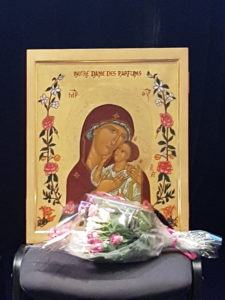
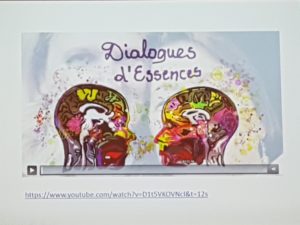
On the other hand, there were two avenues of new thinking that should also be mentioned here. One was a very interesting presentation on the mixing of sight, sound and smell in art that suggests that fragrances can be integrated into entertainment endeavours. This does seem to fit in well with the artistic undercurrent that seems to be a part of the local culture in Grasse. The other is an interest in integrating traditional knowledge with artificial intelligence. This includes, of course, the controversial issue of synthetic fragrances displacing natural sources in the perfume industry, and one senses that this is not exactly where the restoration of the Pays de Grasse’s heritage is heading. The key in both of these avenues, though, is that the industry is changing in rather dramatic ways. These may be the ways the industry actually opens up to more women in the future, but they would also imply a significant revamping of the notion of heritage.
Conclusions
In conclusion, congratulations are due to the Soroptimist Club of the Pays de Grasse for organizing a fascinating colloquium for International Women’s Day. It adds to an appreciation for how this area is engaging in innovative approaches to addressing gender concerns. One might note that some of these efforts tend to be overly politicized and/or really watered down versions of praising women for staying beautiful, bright and charming (as were, reportedly, the accolades coming out of the mouth of one unenlightened (Russian) president).
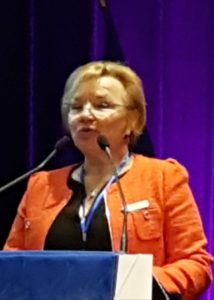

A roundtable event in Grasse on the evening before the Soroptimist event was not quite that bad, but it did seem to throw everything comfortable into the mixing bowl, or, in this case “under the parasol of solidarity”. There was an exchange of statues with the Polish sister city of Opole (the lady with the parasol), honoring the nuns of the Couvant de la Visitation who taught the “bourgeois” girls of Grasse how to make lace, embroidery and such ladylike endeavours in the nineteenth century, a musical event honoring the suffering of women who worked in place of the men who were off fighting during World War I, praise for the organization L’Arache for helping the handicapped, an outreach to girls in Burkina Faso, and cheering the psychological benefit of plastic surgery for women who have had mastectomies! And at the end of the event everyone was handed a little white paper parasol!
Well, it wasn’t what I would call a “roundtable” since no one really interacted, other than a physician and a nurse who shared their enthusiasm for the “centre of beauty” at the Centre Hospitalier de Grasse. The only wrinkle was the inclusion of the President of the Soroptimist Club who did have the opportunity to announce the next day’s colloquium. But fair enough, it was a full menu of examples of where women are making a difference – or made a difference in the past. It might not exactly have given any insights into how one might “balance for better”, but here we are.
In the meantime, there is more to the month than the day. Given that this is Women’s History Month, there will still be opportunities to stop by at the follow-up art exhibit in Peymeinade – plus an expanded exhibit at the Quincallerie d’Art by friend Leila Zarif and her progeny that happens to be running through the month in nearby Nice.
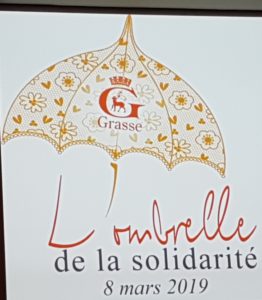
On the other hand, there were two avenues of new thinking that should also be mentioned here. One was a very interesting presentation on the mixing of sight, sound
